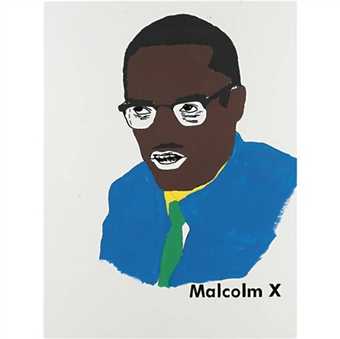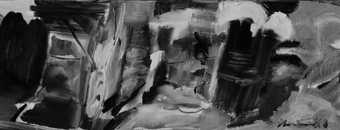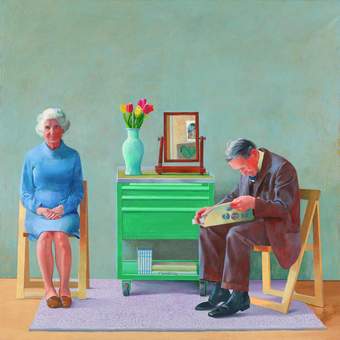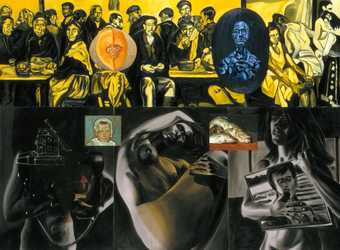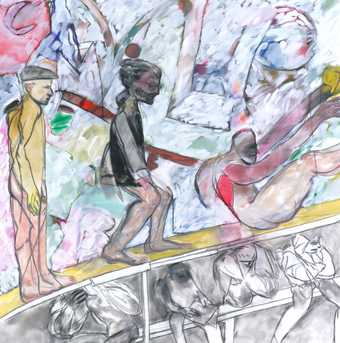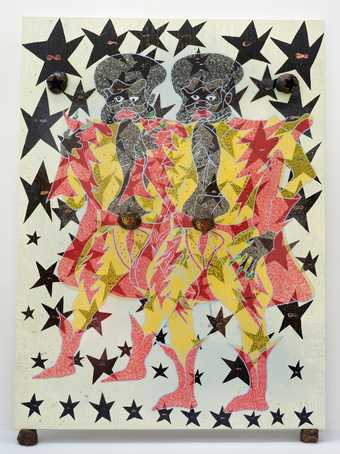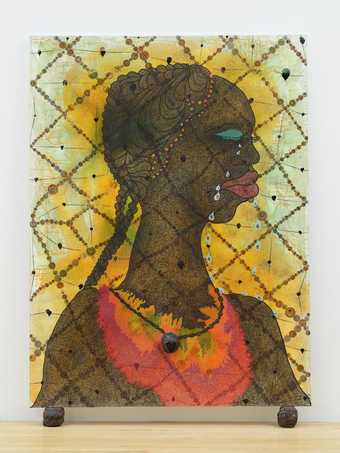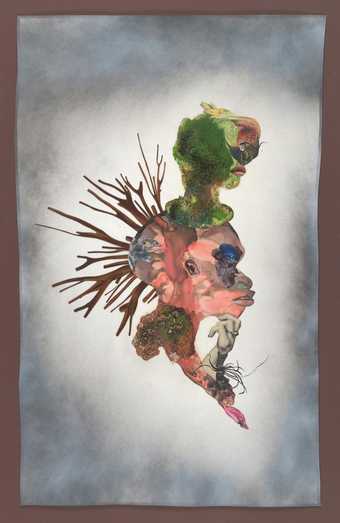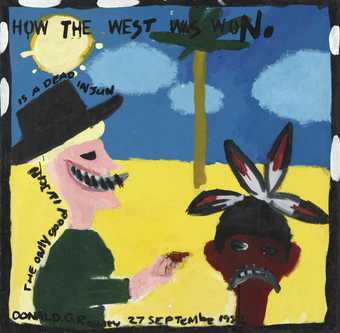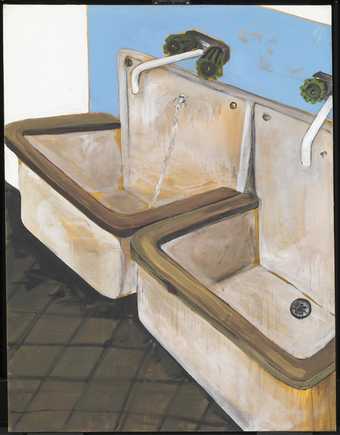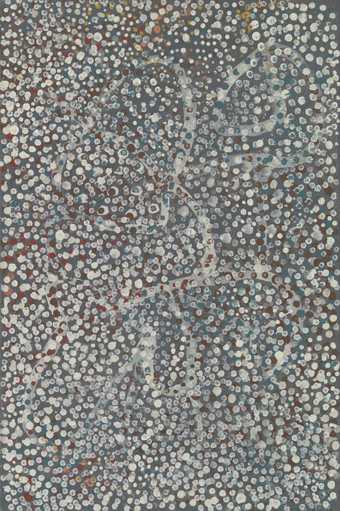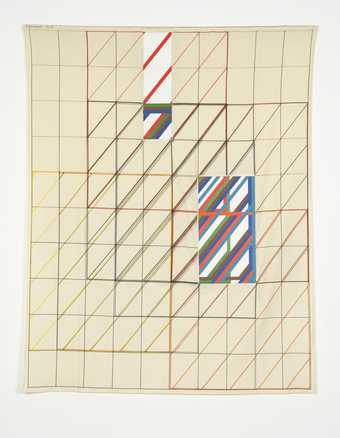
Not on display
- Artist
- Lubaina Himid CBE RA born 1954
- Medium
- Acrylic paint on canvas
- Dimensions
- Support: 1218 × 1524 × 27 mm
frame: 1292 × 1600 × 55 mm - Collection
- Tate
- Acquisition
- Presented by the Patrons of New Art (Special Purchase Fund) through the Tate Gallery Foundation 1995
- Reference
- T06947
Summary
Between the Two My Heart is Balanced 1991 is a large painting depicting two women at sea in a small grey boat. Rendered in thick strokes of acrylic paint, the scene is painted from a vantage point inside the boat, facing the two women. The women, who are both black, are dressed in African-style clothing: the figure on the left wears a check-patterned dress and a tall black headdress, and her companion wears a bright red dress and headdress. At the back of the boat, visible between the bodies of the two women, is a pile of flat, coloured objects. The woman on the left is shown in profile, turning towards her companion while dropping some small blue objects over the edge of the boat into the sea with one hand. She holds a multicoloured item from the stacked pile with the other hand, which is raised to her eye-level. The woman on the right is shown frontally, but her eyes are turned to her left. Her face bears a pensive expression and she tosses small blue objects between her hands, while further pieces can be seen blowing from the boat into the sea to her left. In the background, the water is represented using turquoise, dark green and white paint. The horizon is very near to the top of the picture, so that the cream-coloured sky occupies a shallow band across the upper edge of the canvas. The scene is mostly made up from patches of colour and large, visible brushstrokes, and there is little detail shown. Although the women are depicted in a very flat, frontal style, the shape of the boat and the gradually diminishing size of the waves lend the scene an appearance of depth.
Himid made this painting in her studio in Preston, UK, in 1991. The work shares its title with an etching and drypoint work by the French artist James Tissot (1836–1902) called in French Entre les deux mon coeur balance 1877 (Museum of New Zealand, Wellington), which translates as Between the Two My Heart is Balanced. In Tissot’s etching, which is very similar to his painting Portsmouth Dockyard c.1877 (Tate N05302), a British soldier in a Highland uniform is shown sitting in a small boat between two white women, with a series of grander vessels on the water behind them. Whereas Tissot’s work implies that the man is torn between two potential lovers, Himid’s adoption of the title Between the Two My Heart is Balanced holds alternative implications, suggesting the struggles for identity and belonging faced by migrants travelling across oceans and seas.
According to the artist, the pile of coloured objects that stands between the two women in this work, which occupies the position taken by the male figure in Tissot’s etching, represent maps. That the women appear to be tearing these maps into pieces might be seen as a rejection of forms of knowledge and navigation traditionally controlled by white men. Himid has described the painting along these lines, stating in 2001 that it is ‘a musing on what would happen if black women got together and started to try to destroy maps and charts – to undo what has been done’ (quoted in Rice 2003, p.75).
Himid was born in Zanzibar in Tanzania but moved to England shortly after her birth, and her paintings, woodcuts, installations, works on paper and curatorial projects have often emphasised the contribution of African migrants to the development of European culture. The African-style clothing worn by the women travelling in the boat in this painting suggests a connection with journeys from Africa and the complex cultural politics that are the result of such voyages. As the art historian Alan Rice has suggested, ‘This utopic, calm scene depicts the survival of African culture despite the intervention of slavery and colonialism. The women take control mid-ocean consigning Western charts, which have been the bane of enslaved blacks – crucially allowing Europeans to steer more accurately between African and American slave ports – to the depths of the sea’ (Rice 2003, p.75).
This painting is part of a series entitled Revenge: A Masque in Five Tableaux that the artist finished in 1992. Along with the rest of the Revenge series, this work was first exhibited at Rochdale Art Gallery in 1992. The series comprises twelve works (ten paintings, an installation and a drawing on paper) that includes figurative pieces depicting pairs of black women in a range of scenarios, as is seen in Between the Two My Heart is Balanced and Ankledeep 1991 (Tate T12885), as well as more abstract works suggestive of modernist abstraction and African fabric and textiles, such as Carpet 1992 (Tate T12886). Himid has described the intentions and interactions of the women in her ‘tableaux’ as follows:
The space they occupy is filled with them and expands with their ideas. They have several strategies, they expand to fill the situation. The women take revenge; their revenge is that they are still here they are still artists, that their creativity is still political and committed to change, to change for the good.
(Quoted in Rochdale Art Gallery 1992, p.32.)
The series may therefore reflect Himid’s reimagining of the role of black women in history, with the activities of her female protagonists forming alternatives to conventional historical narratives.
Further reading
Lubaina Himid: Revenge: A Masque in Five Tableaux, exhibition catalogue, Rochdale Art Gallery, Rochdale 1992, reproduced p.26.
Griselda Pollock, Differencing the Canon: Feminist Desire and the Writing of Art’s Histories, London 1999, pp.173–6, reproduced p.174.
Alan Rice, Radical Narratives of the Black Atlantic, London 2003, pp.74–6, reproduced p.74.
Richard Martin
September 2014
Supported by Christie’s.
Does this text contain inaccurate information or language that you feel we should improve or change? We would like to hear from you.
Display caption
This work re-imagines Victorian artist James Tissot’s painting Portsmouth Dockyard c.1877 and is titled after a similar engraving. Tissot’s work features a white British soldier seated in a boat between two white women. In Lubaina Himid’s version, the soldier is replaced with a stack of coloured objects. According to the artist, they are maps which the Black female figures are tearing up and discarding. This action might be seen as a rejection of forms of knowledge and navigation traditionally controlled by white men. Himid has stated the work is ‘a musing on what would happen if black women got together and started to try to destroy maps and charts – to undo what has been done’.
Gallery label, August 2020
Does this text contain inaccurate information or language that you feel we should improve or change? We would like to hear from you.
Explore
- emotions, concepts and ideas(16,416)
-
- emotions and human qualities(5,345)
-
- revenge(2)
- politics and society(2,337)
- clothing and personal items(5,879)
- map(110)
- navigation chart(2)
- black(796)
- government and politics(3,355)
-
- feminism(116)
- colonialism(429)
- migration(20)
- slavery(51)
- boat - non-specific(2,203)
You might like
-
Glenn Ligon Malcolm X (version 2) #1
2000 -
Ivon Hitchens A View from my Roof
1978 -
David Hockney My Parents
1977 -
David Salle Satori Three Inches within Your Heart
1988 -
R.B. Kitaj My Cities (An Experimental Drama)
1990–3 -
Chris Ofili Double Captain Shit and the Legend of the Black Stars
1997 -
John Plumb Hydrastructure - What It Is
1992 -
Chris Ofili No Woman, No Cry
1998 -
Wangechi Mutu You were always on my mind
2007 -
Donald Rodney How the West was Won
1982 -
Lubaina Himid CBE RA Ankledeep
1991 -
Lubaina Himid CBE RA Carpet
1992 -
Sabine Moritz Two Washbasins
1993 -
Emily Kame Kngwarreye Untitled
1990 -
Dóra Maurer Displacements, Step 18 with Two Random-Quasi-Images
1976

